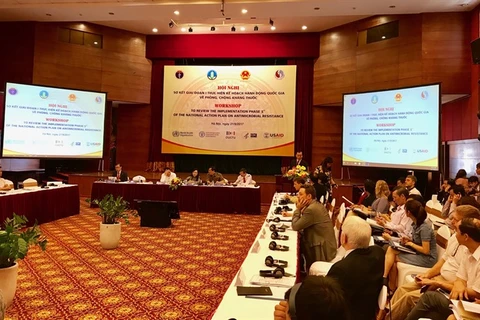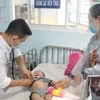HCM City (VNS/VNA) - Antibiotics are overused and misused widely in Vietnam, health experts have warned, calling for drastic measures to curb antimicrobial resistance (AMR) in the country.
At a recent conference on AMR prevention and control in HCM City, president of the city’s Communicable Diseases Association Nguyen Van Vinh Chau said Vietnam’s AMR rate was 40 percent, ranking fourth in Asian-Pacific countries.
According to the World Health Organization (WHO), antimicrobial resistance is the ability of microorganisms, such as bacteria, viruses, fungi or parasites, to grow in the presence of a drug that would normally kill them or limit their growth.
As a result, normal treatments become ineffective, meaning infections become more serious, leading to longer illness, higher treatment cost and greater risk of death.
Because of AMR, a growing number of common infections, such as pneumonia, urinary tract infections, tuberculosis and food-borne illnesses are becoming harder and sometimes impossible to treat.
Vietnam is among the countries that have witnessed a growing threat of AMR, brought about by the irrational use of antibiotics at all levels of the healthcare system, in aquaculture and livestock production and in the community, according to the WHO.
Chau said a major cause for the high rate of AMR in Vietnam was that antibiotics were sold, bought and used without prescriptions.
Studies found that 88 per cent of drug stores dispense antibiotics without a prescription despite the fact it is prohibited by Vietnamese law.
Easy access to antibiotics meant people took unnecessary antibiotics, which resulted in the medicines not working anymore, Chau said.
He also added other factors causing the problems, for example, doctors’ improper prescription, the transmission of antibiotic-resistant bacteria among people in healthcare institutions and the transmission of antibiotic-resistant bacteria from animals to human.
Head of Pharmacy Department of HCM City’s Tropical Diseases Hospital Huynh Phuong Thao said that antimicrobials accounted for more than 50 percent of drugs used in human medicine in Vietnam, and were the most commonly sold drugs in community pharmacies.
“For years, the country failed to control the unlawful sale of antibiotics at stores or the prescription of doctors at private clinics,” she said.
Thao also said that about a third of patients in healthcare institutions used antibiotics without proper prescriptions.
Studies at her hospital found that AMR was reported among 30-40 percent of the patients who received treatment at the hospital. Some cases were resistant to Colistin – the latest antibiotic generation.
Associate Prof. Dr Ngo Thi Hoa from Oxford University’s HCM City-based research unit said the overuse of antibiotics in livestock also caused AMR among people.
“People are exposed to AMR from agriculture production through three main ways including the direct contact to animals that consume antibiotics, contact to the animal waste that is discharged into the environment and people consume products like meat, eggs or milk of animal that are fed with antibiotics,” Hoa said.
While the number of antibiotic-resistant bacteria is increasing, few new antibiotics have been developed, she said, adding that 19 antibiotics were found in 1980 but only six in 2010.
Notably, the life of an antibiotic in the past could last decades but today, on average, a new antibiotic faces the threat of its resistant bacteria within five years, she said./.
At a recent conference on AMR prevention and control in HCM City, president of the city’s Communicable Diseases Association Nguyen Van Vinh Chau said Vietnam’s AMR rate was 40 percent, ranking fourth in Asian-Pacific countries.
According to the World Health Organization (WHO), antimicrobial resistance is the ability of microorganisms, such as bacteria, viruses, fungi or parasites, to grow in the presence of a drug that would normally kill them or limit their growth.
As a result, normal treatments become ineffective, meaning infections become more serious, leading to longer illness, higher treatment cost and greater risk of death.
Because of AMR, a growing number of common infections, such as pneumonia, urinary tract infections, tuberculosis and food-borne illnesses are becoming harder and sometimes impossible to treat.
Vietnam is among the countries that have witnessed a growing threat of AMR, brought about by the irrational use of antibiotics at all levels of the healthcare system, in aquaculture and livestock production and in the community, according to the WHO.
Chau said a major cause for the high rate of AMR in Vietnam was that antibiotics were sold, bought and used without prescriptions.
Studies found that 88 per cent of drug stores dispense antibiotics without a prescription despite the fact it is prohibited by Vietnamese law.
Easy access to antibiotics meant people took unnecessary antibiotics, which resulted in the medicines not working anymore, Chau said.
He also added other factors causing the problems, for example, doctors’ improper prescription, the transmission of antibiotic-resistant bacteria among people in healthcare institutions and the transmission of antibiotic-resistant bacteria from animals to human.
Head of Pharmacy Department of HCM City’s Tropical Diseases Hospital Huynh Phuong Thao said that antimicrobials accounted for more than 50 percent of drugs used in human medicine in Vietnam, and were the most commonly sold drugs in community pharmacies.
“For years, the country failed to control the unlawful sale of antibiotics at stores or the prescription of doctors at private clinics,” she said.
Thao also said that about a third of patients in healthcare institutions used antibiotics without proper prescriptions.
Studies at her hospital found that AMR was reported among 30-40 percent of the patients who received treatment at the hospital. Some cases were resistant to Colistin – the latest antibiotic generation.
Associate Prof. Dr Ngo Thi Hoa from Oxford University’s HCM City-based research unit said the overuse of antibiotics in livestock also caused AMR among people.
“People are exposed to AMR from agriculture production through three main ways including the direct contact to animals that consume antibiotics, contact to the animal waste that is discharged into the environment and people consume products like meat, eggs or milk of animal that are fed with antibiotics,” Hoa said.
While the number of antibiotic-resistant bacteria is increasing, few new antibiotics have been developed, she said, adding that 19 antibiotics were found in 1980 but only six in 2010.
Notably, the life of an antibiotic in the past could last decades but today, on average, a new antibiotic faces the threat of its resistant bacteria within five years, she said./.
VNA
























